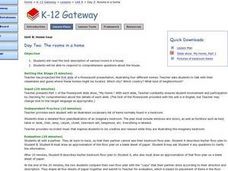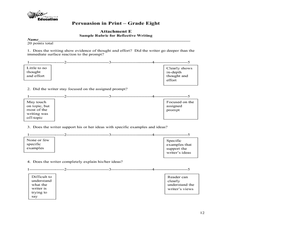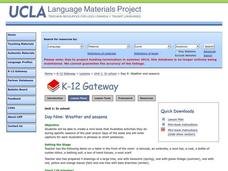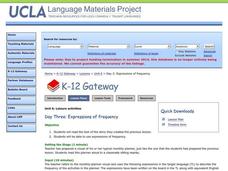Scholastic
Identifying a Target Audience
How do advertisers try to speak to you? Learners review a variety of advertisements and identify how they attempt to reach a particular targeted audience, as well as consider what type of audiences they might belong to as young...
Franklin D. Roosevelt Presidential Library & Museum
Pearl Harbor Activity #4: Who is the Audience?
Young historians use the prompts on a worksheet to analyze President Roosevelt's "Day of Infamy" speech. They identify the intended audience for the speech, the devices FDR used to persuade his audience, the responses promoted, and the...
Media Smarts
The Newspaper Front Page
Hot off the presses! A perfect instructional activity idea for a journalism class or even a language arts class looking to incorporate some informational texts. Young writers analyze the front pages of various newspapers to determine the...
Curated OER
PETA Pressure
High schoolers examine what a "target audience" is and evaluate the PETA website for tactics that exploit the characteristics of their target audience. They read and discuss a handout, analyze the PETA website in small groups, and...
Curated OER
The Rooms in a Home
Enhance your foreign language students' skills to describe a house. After reading a description of rooms in a house in their target language, they work to answer corresponding questions correctly. Additionally, they view a PowerPoint...
Newseum
Persuasion Portfolios
After class members brainstorm a list of current social and political issues, groups each select a different topic from the list to research. Teams create a portfolio of at least 10 examples of stories about their issue, stories that...
Curated OER
Sports Personalities in Advertising
During a series of four activities, class members examine and deconstruct advertising that features famous athletes. They determine target audiences, analyze ads, explore "emotional climate," and role play a meeting between a sports...
Curated OER
Persuasive Language
Pupils read a persuasive story study persuasive language. They then write a 50-word online advertisement for a target audience to try and sell an unusual item to a targeted audience.
Curated OER
Writing: Advertisements
Students explore these web pages to explore how to write good advertisements.
Curated OER
Persuasion in Print
Advertisers target teenagers. Groups select three magazine advertisements for similar products, analyze the appeals used in each, create a poster that features the persuasive techniques used, and present their findings to the class. The...
Curated OER
Time Capsule: Oral Presentation
A great way to gain proficiency when learning a new language is to prepare an oral presentation. In this foreign language lesson, pairs collaborate to develop a Time Capsule which they present to their class using their target...
Curated OER
Writing a News Story
Students practice using their target language by writing a news article. In this foreign language writing instructional activity, students create a fictional "hero" in their city which they write a fictional news article about in...
University of Southern California
Persecution of the German-Jews: The Early Years - 1933-1939
Young historians learn about the dehumanization process of stripping German Jews of basic, fundamental rights prior to the genocide of European Jews in the 1940s. Learners watch video clips of survivors who recount such events...
Curated OER
Language Arts: Putting Together a Position Paper
Students are able to identify the target audience for their writing. They are able to create an appropriate format for their papers. Students are able to focus on the developing clear arguments and supporting all key points with facts.
Curated OER
Favorite Activity
Learners write persuasive essays about favorite activities. They present on a topic of personal interest or one that has been studied in another subject area. They write a composition of a favorite activity, describing the activity and...
Curated OER
Marketing to Teens: Marketing Tactics
Enlighten young consumers to advertising techniques aimed specifically at their generation. Have learners answer questions about how advertisements are geared for a younger audience, then have them practice selling to other teenagers....
Curated OER
What Do You Say... Psa Part One
Students investigate the differences between advertisements and public service announcements. They monitor their own reactions to educational messages as they pertain to warning about specific dangers and apply this to target audiences.
Curated OER
The Causes and Course of the First World War
Use this twelve-day lesson plan to teach about the causes and courses of WWI. Each day scholars attend lectures, complete creative activities, and hold round table discussions on what they've learned. Web links and resources are...
Curated OER
Egg Hunt Lesson
Fourth graders explore religious holidays by participating in an egg hunt. In this Easter instructional activity, 4th graders review the different U.S. states and capitols before completing a geography egg hunt activity. Students read...
Curated OER
Weather and Seasons
Use pictures and manipulatives to develop vocabulary with your beginning language learners. This plan can be used with foreign language learners (although you'll have to provide the vocabulary), English language learners, or a young...
Curated OER
Como Se Hace...?
Students work in groups to give step-by-step instructions to the rest of the class about an activity of interest. They write presentation proposals, research the activity and then draft and edit a presentation. Students present their...
Curated OER
Project-Based Learning: Community Service
Community service is the basis for a project based learning experience. Your class participates in four weekly activities that require them to research community issues and contribute their time and talent to assist those in need. This...
Curated OER
Expressions of Frequency
Students practice discussing timely manners in a target language. In this foreign language lesson, students discuss words that represent frequency such as never or often. Students create a timeline illustrating how often...























